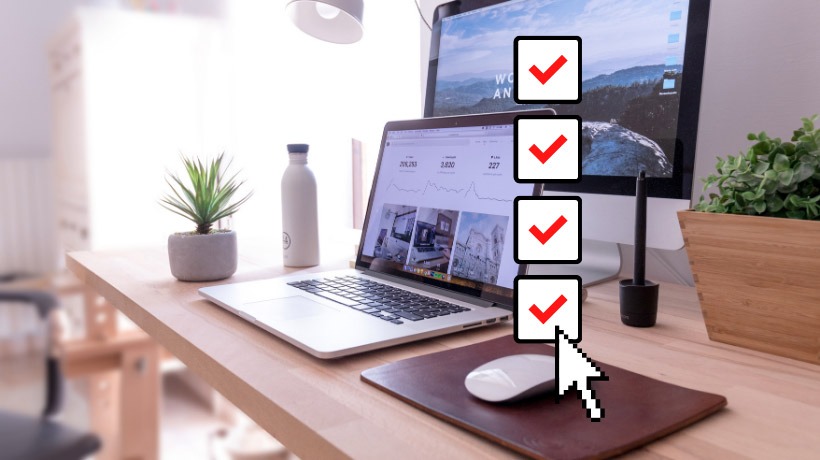
Domain name scams and how to spot them
November 26, 2020
How to clean up your website
May 6, 2021There’s no one-size-fits-all for what a business website should include. It depends entirely on what type of business you are. Do you have brick-and-mortar locations? Is most of what you do online or in-person (e.g., eCommerce store vs plumbing services)? However, there are common elements to business websites, which we’re going to talk about today.
What your website should have:
- Fast, reliable, secure hosting
- A straightforward domain name
- Well-defined navigation
- A description of who you are and what you do.
- Design that’s effective, responsive, accessible.
- Smartly utilised images
- A clear call to action
- An obvious way to contact or find your business.
- Transparent policies
- New content
Fast, reliable, secure hosting
Where should you host your website: in Australia or overseas? When you host here, you benefit from geography – the signal has a shorter distance to travel, so it’s faster. (Website speeds can be affected by many different parameters, but if your host is local, hosting won’t be one of them.)
From time to time, websites do go down and you’ll want to make easy contact with support to get your site up and running again. With overseas hosting, you may experience customer service delays due to time zone differences, how they manage high quantities of enquiries, and you may never talk to the same person twice! This can happen with local hosts too. It’s just a matter of knowing what you’re in for ahead of time.
Using overseas hosting may appear cheaper, but you may be trading off some value for that cut-rate price. The bottom line? Research what will work best for you, and be aware of the risk factors ahead of time.
Further reading: Check out our post, “What’s the difference between web hosting and a domain name?”
A straightforward domain name
You likely already have a domain name unless you’re launching a new business. But if you do need a new domain name, be selective.
Keep it short and memorable. Avoid hyphens and creative spellings. We’ve got more help for you here on our post choosing a domain name for a new website.
Well-defined navigation
Some websites sacrifice utility in the name of design, especially with navigation. Utility and design are not mutually exclusive of course, but it’s in everybody’s best interest that navigation menus are easy to use.
For some, it can be very on-brand to be creative with the words used in the menu, but if it stops your customer from finding what they need fast, the website just failed a vital test. Make your customer’s path through your website bleedingly obvious.
Your web developer can advise you on simplifying your navigation.
A description of who you are and what you do.
Use your about page to make a connection with your customer. Often the only avenue for customers to relate to you is what you share on your website, especially if they don’t interact with you face-to-face. So, explain your business, your philosophy, your people. Be approachable, likeable, and show some of your brand personality while remaining authentic.
Design that’s effective, responsive, accessible.
Outstanding design can lift how others view your business online – that makes it important. But always balance good design with its practical uses. Absolutely make sure it looks sophisticated – but keep your eyes on the prize, a website that works for both your customers and your business.
Prioritise responsive design on your website – that’s the layout that changes to suit the device where it is viewed. Placing an order on an eCommerce store should be as easy on my smartphone as on a huge desktop monitor. All website functionalities should be equally accessible on all devices without having to zoom in or out or switch them off completely.
If your website is accessible, that means people with diverse abilities have equal opportunity and equal access to your website. This benefits people with disabilities, older people, and those living in rural and remote areas. Web accessibility also helps people without disability, such as closed captions being available on videos so they can be understood without sound. Accessibility involves the design and function of websites to allow people to use screen readers, Braille terminals, screen magnification, closed captions, etc. Your web developer can advise you on improving website accessibility.
Smartly utilised images
The images used on your website show who you are and what you do. They help build trust and prove you’re the real deal. Websites are visual media, and letting a photographic representation of your business slide is a missed opportunity. It sounds expensive and work that not everybody is cut out for, but I can tell you – we see photographs from all kinds of sources, and you’d be surprised by what we can do with a well thought out image taken on a smartphone in strong natural light.
Having a professionally shot set of images to draw upon can make or break a website. Selectively using stock images can be helpful, but they can look inauthentic. There is a lot to consider, and showing your business on your website is worthy of careful thought.
A clear call-to-action
What do you want people to do when they come to your website? Make a purchase, get in contact, book an appointment? Make your call to action nice and clear.
It seems obvious, but you need to tell website visitors what you want them to do. There are many ways to do this, and your web designer should advise you on this. It may mean a prominent “Book an appointment” button or an eye-catching section “Want to know how we can make your home landscaping dreams a reality? Button: Get a Quote”.
An obvious way to contact or find your business.
Including a contact page goes without saying but how easy to find is it? Make it plain in your top navigation menu, your footer, or as a call-to-action button, as we mentioned above.
Consider adding additional fields to your contact form that your customer will find helpful – more than the obligatory name, email, message, then submit. How can you use your form to get more information? For example, would it be helpful to have them select the type of enquiry they are making? Or if they are asking about an order update, perhaps a field where they can enter their order number would be useful. Be selective with adding fields – there’s no need to add everything imaginable, but a few cleverly chosen fields could help speed communications up between you and your customer.
Transparent policies
Privacy Policy
If you are collecting information about your site visitors, you are going to need a Privacy Policy. Tell visitors what you plan to do with the information they supply during the use of your website or business; email address, contact details, or cookies.
Terms & Conditions
With an eCommerce website, you must display terms and conditions. People need to know what they are signing up for when they buy from you.
Returns, Shipping, Currency
If your site is eCommerce, your clients need to know about your policies for shipping, returns, and currency. If you don’t show all this information, your business may look suspect or unprofessional and deter buyers. Be transparent about your returns and shipping policies, and you will build trust in your online store.
New content
Keeping website content fresh is like changing window displays in a shop front. It lets people know things are happening and worthy of their attention. If overlooked, it can appear that nobody’s home at the business. This is especially true if your venture is online-only.
Fresh content might mean:
- changing out photographs on the homepage now and then,
- adding and featuring a new blog post (if you have a blog),
- changing messaging or calls-to-action,
- making sure your email marketing or social media marketing campaigns are reflected on your website too.
Keeping content up-to-date might also mean modifying how you present your services or products as your business evolves.
One thing we do recommend about content is setting yourself reminders to do this. In the daily grind of running a business, keeping your website fresh can get bumped down the to-do list (trust us, we know!). Suddenly, months have passed. So set a weekly, monthly, or quarterly reminder (whatever works best for you) to make sure you’re keeping it fresh on your website.
–
Need guidance on developing your new website and what it should include?



2 Comments
Well, We impressed with your work on this topic, You have shared very impressive information and suggestions they amazing and very help us.
Thanks for sharing such a valuable information with us.
Thanks for taking the time to discuss such a nice blog with us.
keep sharing.